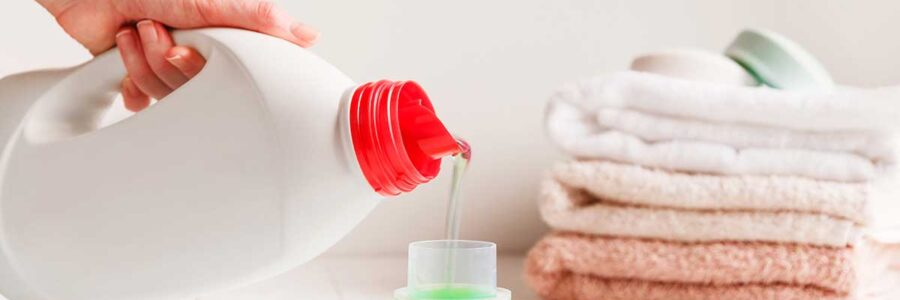The Top 10 Toxins to Avoid in Laundry Detergents
Most people don’t give much thought to the ingredients in their laundry detergents. However, many commercial products contain chemicals that can be harmful to our health and the environment. Here are the top 10 toxins to watch out for in laundry detergents and a simple recipe for making your own natural laundry soap.
- Phthalates Phthalates are commonly found in synthetic fragrances. These chemicals can disrupt endocrine function and are linked to various health problems, including reproductive issues. To avoid phthalates, choose detergents labeled “fragrance-free” or those scented with natural essential oils.
- Sodium Lauryl Sulfate (SLS) and sodium laureth sulfate (SLES) are surfactants that can cause skin and eye irritation and may be contaminated with 1,4-dioxane, a possible carcinogen. Opt for detergents that use plant-based surfactants instead.
- 1,4-Dioxane is a byproduct of the detergent manufacturing process and a probable human carcinogen. It can also cause skin irritation. Look for detergents that are “1,4-dioxane-free” or certified by a reliable third-party organization.
- Nonylphenol Ethoxylates (NPEs) NPEs are surfactants that can disrupt hormone function and are toxic to aquatic life. Choose detergents labeled “NPE-free” to protect your health and the environment.
- Optical Brighteners Optical brighteners are chemicals that make fabrics appear brighter and whiter. They can cause skin irritation and are not biodegradable, threatening aquatic environments. Avoid detergents that list “optical brighteners” on their label.
- Chlorine Bleach Chlorine bleach can cause respiratory issues and skin irritation. When released into the environment, it also produces harmful byproducts. Use oxygen bleach or hydrogen peroxide-based alternatives instead.
- Artificial Fragrances Artificial fragrances can contain numerous chemicals, allergens, hormone disruptors, or carcinogens. Choose unscented products or those scented with natural essential oils.
- Ammonium quaternary sanitizers (Quats) are used for their antimicrobial properties, but they can trigger asthma and other respiratory issues. Opt for detergents that do not contain quaternary ammonium compounds.
- Formaldehyde Formaldehyde is sometimes used as a preservative in detergents. It is a known carcinogen and can cause skin and respiratory irritation. Look for formaldehyde-free products to reduce exposure.
- Phosphates Phosphates can cause environmental damage by contributing to water pollution and algal blooms, which deplete oxygen in water bodies and harm aquatic life. Choose phosphate-free detergents to help protect water ecosystems.
Homemade Laundry Soap Recipe
Making your own laundry detergent is a great way to avoid these harmful chemicals and save money. Here’s a simple recipe for homemade laundry soap:
Ingredients:
- 1 bar of Castile soap (or any natural, fragrance-free soap)
- 1 cup washing soda (sodium carbonate)
- 1 cup baking soda (sodium bicarbonate)
- 1 cup borax (sodium borate)
Instructions:
- Grate the Soap: Use a cheese grater to finely grate the soap bar.
- Mix the Ingredients: In a large bowl, mix the grated soap, washing soda, baking soda, and borax until well combined.
- Store: Transfer the mixture to an airtight container.
To Use: Add 2-3 tablespoons of homemade laundry soap to your washing machine for each load of laundry.
This homemade laundry soap is free from harmful chemicals and gentle on both your clothes and the environment. Plus, it’s easy and cost-effective to make!
References:
- Wang, Yufei, and Haifeng Qian. “Phthalates and Their Impacts on Human Health.” Healthcare, vol. 9, no. 5, May 2021. www.ncbi.nlm.nih.gov
- Bondi, Cara AM, et al. “Human and Environmental Toxicity of Sodium Lauryl Sulfate (SLS): Evidence for Safe Use in Household Cleaning Products.” Environmental Health Insights, vol. 9, Nov. 2015, pp. 27–32. PubMed Central
- PubChem. Edetic Acid. https://pubchem.ncbi.nlm.nih.gov/compound/6049. Accessed 5 June 2024.
- Badmus, Suaibu O., et al. “Environmental Risks and Toxicity of Surfactants: Overview of Analysis, Assessment, and Remediation Techniques.” Environmental Science and Pollution Research International, vol. 28, no. 44, 2021, pp. 62085–104. PubMed Central
- Ask Dr. Pete: What Are Optical Brighteners and Why Should We Care?” Dirty Labs, https://dirtylabs.com/blogs/the-dirt/what-are-optical-brighteners-and-why-should-you-care. Accessed 5 June 2024.
- Benzoni, Thomas, and Jason D. Hatcher. “Bleach Toxicity.” StatPearls, StatPearls Publishing, 2024. PubMed
- Rádis-Baptista, Gandhi. “Do Synthetic Fragrances in Personal Care and Household Products Impact Indoor Air Quality and Pose Health Risks?” Journal of Xenobiotics, vol. 13, no. 1, Mar. 2023, pp. 121–31. PubMed Central
- Arnold, William A., et al. “Quaternary Ammonium Compounds: A Chemical Class of Emerging Concern.” Environmental Science & Technology, vol. 57, no. 20, May 2023, pp. 7645–65. PubMed Central
- PubChem. Formaldehyde. https://pubchem.ncbi.nlm.nih.gov/compound/712. Accessed 5 June 2024.


